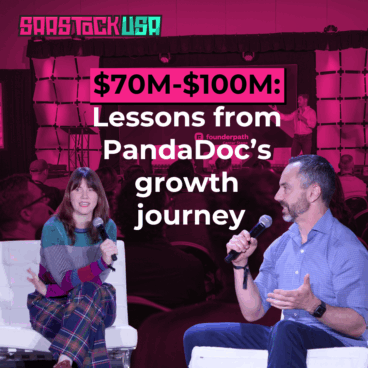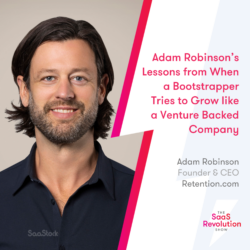Live from SaaStock USA, PandaDoc President Keith Rabkin joins Go Nimbly CEO Jen Igartua to reveal the strategies that took them from $70M to $100M ARR in just 2.5 years.
In the 20 minute chat, Keith shares:
- How PandaDoc wins against incumbents DocuSign and Salesforce.
- The strategy that helped PandaDoc increase financial results, despite headcount decreasing through attrition.
- One metric that eliminates sales and marketing friction.
- The AI implementations that are actually driving results.
Watch (or listen) below or read on for key takeaways.
Moving upmarket and competing against incumbents
“We saw that customers were growing out of PandaDoc…customers who were using us for quotes and proposals were graduating into CPQ. And so it was natural that we wanted to help these customers continue to succeed.”
With 60,000 customers and 650 employees, PandaDoc has built serious momentum. And now, they’re successfully moving upmarket from their historically SMB customer base and are winning deals against giants like Docusign and Salesforce.
Here’s how they approach it:
Target your ICP and build for them
Going up against incumbents starts with understanding exactly who you’re serving:
“[When you’re] really specific about what you’re going after and you target a specific ICP and you build your product for them, the doors open up.”
Stay focused on your core, then expand thoughtfully
PandaDoc didn’t try to do everything at once. What started as a proposal and quote tool, gradually expanded into contracts and is now working with more complex quotes and QPC.
“Being really focused on that kernel that your customers love and then building off that is really important,” Keith explains.
Build teams that believe in the mission
Perhaps most importantly, Keith points to the power of passionate founders and teams.
“Our entire sales team loves selling our product because they know it brings value to our customers.”
When your team genuinely believes in what they’re selling, it shows. Customers can tell the difference between someone pushing a product and someone solving their problem.
Prioritising efficiency: Knowing when to take a step back
Growth isn’t always about adding more people or doing more things. Sometimes it’s about stepping back and asking what’s actually working:
“At some points, you have to take a step back and you have to look at where did you get complacent? Where did you get lazy? Where did you start to find easy things that are distracting you from the core mission?”
During this exercise, PandaDoc decreased headcount through attrition but with the changes they made, financial performance still increased. The key was returning to first principles and asking, “How do we make it easy for the customer?”
Building efficient GTM processes
Keith is focused on creating smooth operating systems that help his team focus on the best opportunities. It involves forcing scarcity and pushing the team to their limit with accounts.
“When we add accounts, these hunters, they get really focused on the best opportunities,” he explained.
This allows them to only add people when it’s absolutely necessary.
“I try to make sure that we do it until the pressure is about to burst and then we go make that additional hire.”
The AI bets that are driving results
This approach to GTM requires processes that allow the team to spend time where they add the most value. But for Keith, this doesn’t mean rushing to the latest AI solution.
Rather, he waits to see what’s working for others:
“Let a thousand flowers bloom, let a bunch of people experiment with it, find what works, and let the cream rise to the top.”
Operationally, the biggest win has been getting focussed on their ICP:
“We rolled out an AI tool that identified ICP based on who was in our CRM, suggested lookalikes, and then started with some talking points for our AEs. It half drafted the outbound for us and that was a real significant lift in our outbound motion.”
They also use Gong’s conversational intelligence to analyse conversations and push those summaries into its CRM. Again, to save the team time so they can add value elsewhere.

Aligning sales and marketing around one metric
Ask any founder about sales and marketing alignment, and you’ll hear stories about MQL disagreements and finger-pointing. Keith solved this with one shared metric.
“We solved it by focusing on a single metric for both sales and marketing… we do pipeline dollars because it requires both marketing and sales to agree.”
The results speak for themselves: “When I get the VP of sales and the VP of marketing in a room, they will take the blame for the low pipeline themselves and not blame the other one, which I love to see.”
Testing and learning at speed
With alignment (and LLMs) comes the ability to move fast. Keith’s team built “a very fast testing and iterating cycle” where they can test different website messaging and “translate it all the way into pipeline and leads.”
Having massive traffic helps them reach statistical significance quickly, but the principle applies at any scale: test, measure pipeline impact, iterate.
The key to staying focused; repeat, repeat, repeat
Keith admits he’s “actually terrible” at saying no to new ideas but encourages his team to call him out.
They know when to call him out because he relentlessly repeats the focus and mission.
“I love the phrase repetition doesn’t spoil the prayer. You have to repeat it over and over and over and over again,” Keith explains. “Outbound, outbound, outbound, outbound. Value based selling over and over and over and over. Marketing, same thing. ICP, ICP, ICP.”
The strategy isn’t written down somewhere. It’s built into the culture through constant reinforcement.
Though there is still some time for what Keith calls “asymmetric bets”. That is, opportunities where “one plus one equals five, not the thing that’s one plus one equals two.” With time as your scarcest resource, focus on the things that will have disproportionate impact.
Discover more highlights from SaaStock USA
From data-driven keynotes, to company deep-dives, to live podcasts, SaaStock USA had it all.
Catch up on the best bits:





